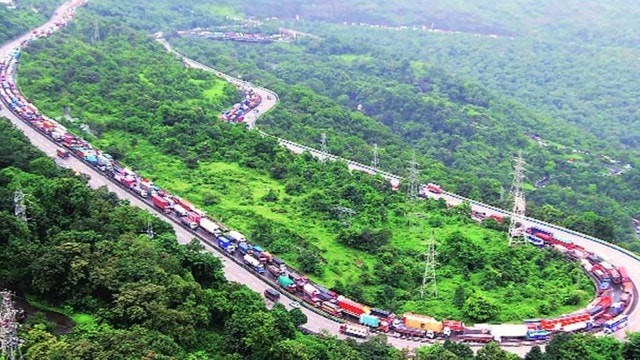ITMS goes live on Mumbai-Pune Expressway: Initial hiccups in real-time challan issuance
State transport commissioner Vivek Bhimanwar explained that since this is the first instance of ITMS being introduced on any highway in Maharashtra, they are facing some challenges.
 The 94-km long new expressway starts at Kalamboli (in Raigad district) in Navi Mumbai and ends at Kiwale (in Pune). (File photo)
The 94-km long new expressway starts at Kalamboli (in Raigad district) in Navi Mumbai and ends at Kiwale (in Pune). (File photo)Aiming to revolutionise road safety, the Intelligent Traffic Management System (ITMS) was launched on the Mumbai-Pune Expressway on the entire stretch just a week ago. This cutting-edge system is designed to monitor and regulate traffic violations in real time. However, despite going live, it is yet to issue real-time challans to traffic violators, revealing teething troubles in its initial stage of operations.
State transport commissioner Vivek Bhimanwar explained that since this is the first instance of ITMS being introduced on any highway in Maharashtra, they are facing some challenges. He, however, said that with time and adjustment to the system and software, it will be overcome. The ITMS is already being used worldwide on many highways to curb traffic violations.
“We are at a learning stage, understanding the system,” he stated. Currently, an external agency, which has set up the ITMS, initially collects data on traffic violators. This data is then sent to the transport assistant inspectors for evaluation, as the agency lacks the authority to issue challans directly.
Interestingly, India’s first access-controlled expressway, the Mumbai-Pune Expressway, was inaugurated in 2002.
Also known as the Yashwantrao Chavan Expressway, it was constructed by the Maharashtra State Road Development Corporation (MSRDC), which also executed the project. Now, it has achieved another milestone by becoming the first expressway in the state to be equipped with an Intelligent Traffic Management System (ITMS) comprising AI cameras.
The 94-km long new expressway starts at Kalamboli (in Raigad district) in Navi Mumbai and ends at Kiwale (in Pune).
Bhimanwar pointed out significant challenges within the system, including instances where the ITMS has mistakenly issued challans. “For example, the system has issued challans to a pillion rider using a phone next to the driver, and in another case, a commuter was fined for not wearing a seatbelt even though he was wearing one. These and other software glitches need correction, as the AI-operated cameras function without human interference. This contributes to a notable delay in challan issuance, currently taking more than three to four days. However, we are working to reduce this time to within 48 hours of the offence. Our instruction is clear: it’s acceptable if a challan isn’t issued, but issuing a wrong challan is not.”
The new ITMS features AI-equipped cameras with advanced technology installed every 10 kilometres along the 94-km stretch of the Yashwantrao Chavan Mumbai-Pune Expressway. These cameras are capable of identifying 11 types of traffic violations. Positioned on gantries and poles, each 10 km radius has a gantry equipped with three cameras.
The ITMS was operational only on the ghat section of the expressway initially in March this year. Now, it has been expanded to cover the entire stretch. However, the old Mumbai-Pune Expressway remains outside the system’s purview.
Despite its promising potential, the ITMS faces several challenges that must be addressed to realise its full capability. The transport department remains optimistic, working diligently to streamline the process and enhance road safety on one of Maharashtra’s busiest highways, which sees a high traffic density of 80,000 to 100,000 vehicles daily.
Currently, aside from the private agency, there are 10 traffic assistant inspectors at the Kusgaon, Lonavala Control Centre established for ITMS monitoring 24×7. According to the state transport wing, they plan to double this number to enhance monitoring capabilities.
The introduction of ITMS has significantly increased the number of daily challans issued, from a mere 100-200 to about 4,000. Previously, an interceptor vehicle was deployed on the expressway to issue challans. This vehicle could only cover a range of 400 metres and was manned by a human, operating for a few hours rather than 24×7. In contrast, the ITMS operates continuously, addressing common offences such as driving in the wrong lane, lane cutting, and over-speeding. The AI-based cameras aim to control these violations and significantly enhance road discipline by monitoring and penalising vehicles driving beyond the speed limit.
The interceptor vehicles have now been shifted to the old Mumbai-Pune Expressway. Bhimanwar noted that despite the ITMS implementation, visible highway patrolling has not been completely withdrawn. The presence of patrolling continues to act as a deterrent to traffic violations, especially since the ITMS currently issues challans with a delay of 4-5 days. Traffic patrolling marshals continue to flash lights during night time to maintain order.
This ambitious project was undertaken by the Maharashtra State Road Development Corporation (MSRDC). The state transport commissioner’s office plans to extend similar projects to other major highways in the state. Six tenders have already been floated, including for ITMS implementation on the old Mumbai-Pune Expressway. The success of these initiatives could set a new standard for traffic management and road safety across the state.
ITMS Overview
Mumbai–Pune Expressway (Yashwantrao Chavan Expressway 94km)
– India’s first 6-lane wide concrete, access-controlled tolled expressway
– Starts at Kalamboli (Raigad district) in Navi Mumbai
– Ends at Kiwale (Pune)
– Commissioned in 2002
– 22-year-old expressway
ITMS Infrastructure
– Total cameras: 115
– Installed on: 45 gantries & 50 poles
Traffic Violations Detected (11 types)
– Driving without a seatbelt
– Talking on the phone while driving
– Wrong lane driving
– Lane cutting
– Speeding beyond the restricted limit
– Rash driving
– Vehicle without a proper fitness certificate
– And others
Impact of ITMS
– Increased challan issuance to over 4,000 per day from the previous 100-200 challans being issued
– ITMS operates 24×7, unlike human-operated interceptor vehicles
– Enhances traffic regulation and driving discipline












